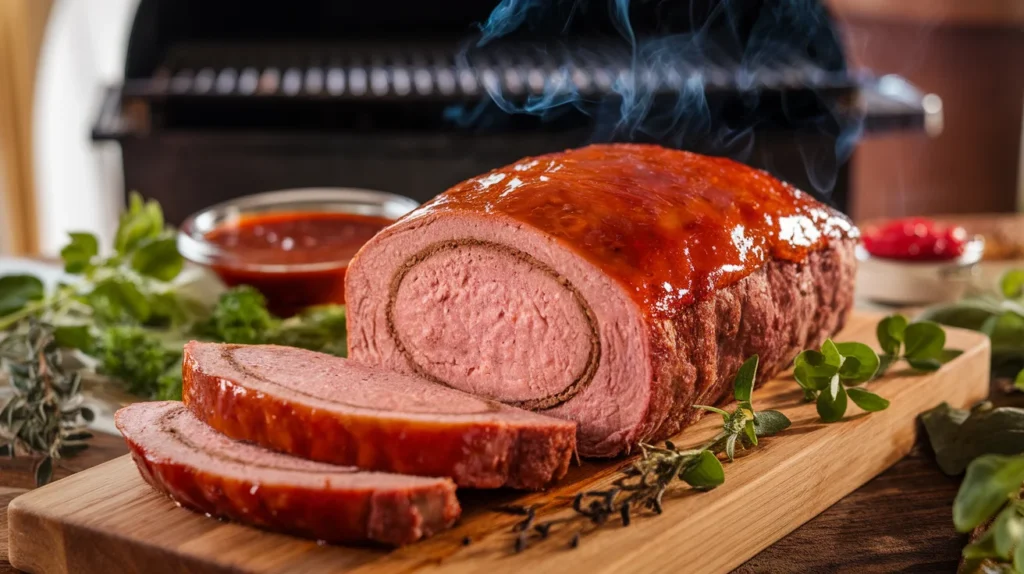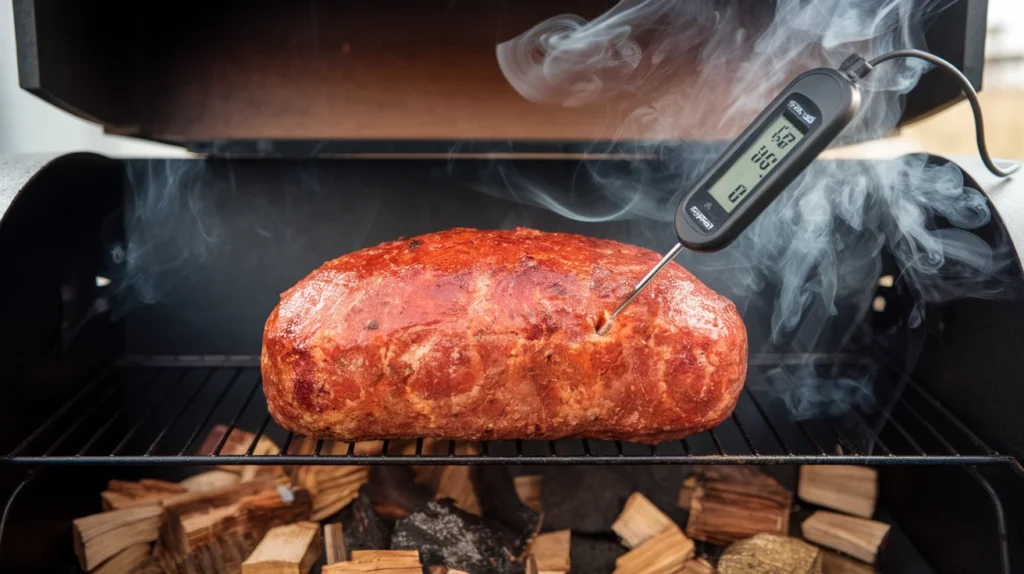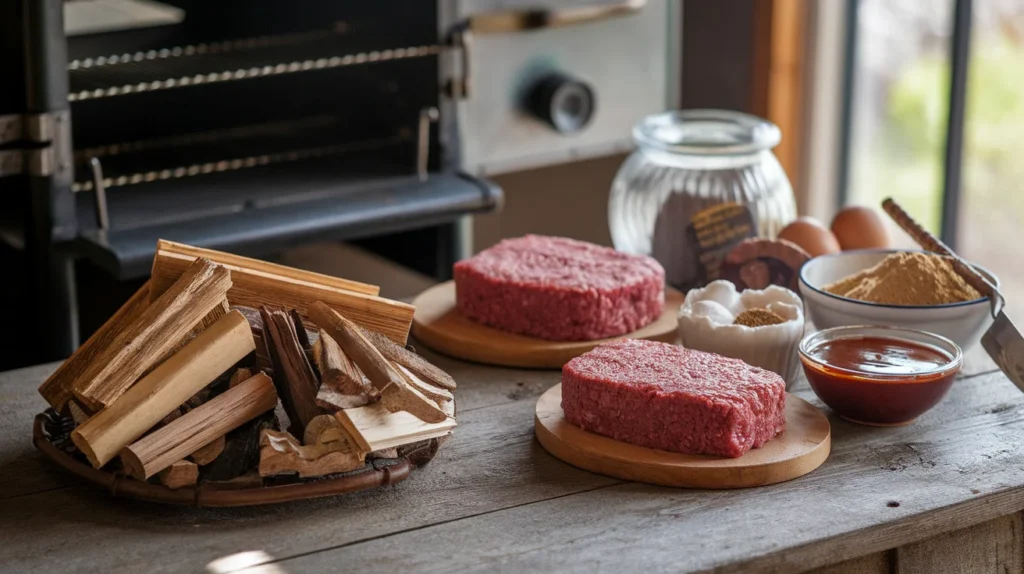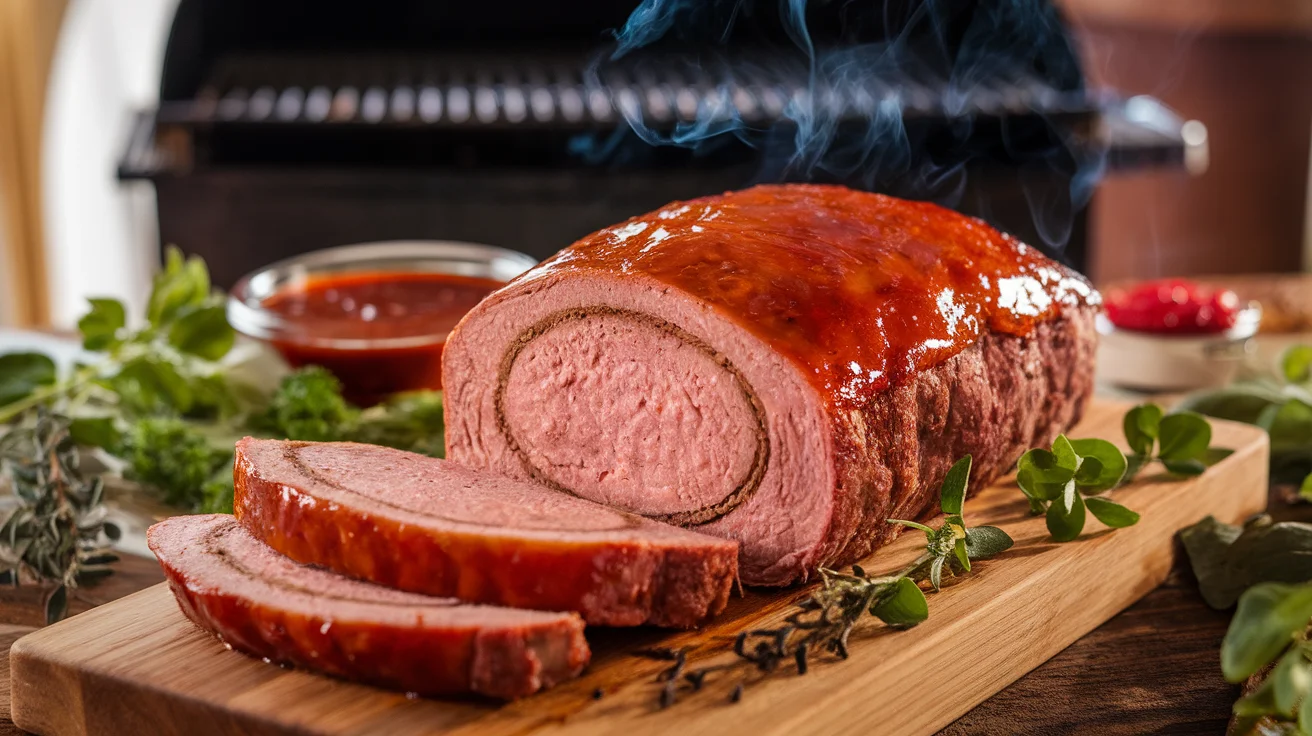Introduction
Smoking meatloaf is a culinary technique that infuses this classic dish with deep, smoky flavors, elevating its taste and texture to new heights. However, one common question that arises during the smoking process is: Does smoked meatloaf stall? If you’ve smoked larger cuts of meat like brisket or pork butt, you might be familiar with the phenomenon called the “stall,” where the meat’s internal temperature plateaus for an extended period.
In this article, we’ll explore whether smoked meatloaf experiences the same stall, why it might happen, and how to handle it effectively. We’ll also cover practical tips for achieving perfectly smoked meatloaf and explain why smoking is worth the effort, even if you encounter a stall. Let’s dive in!
What is Smoked Meatloaf and Does It Stall?

Ingredients
Smoked meatloaf is a flavorful twist on the traditional meatloaf, prepared by slow-cooking the meat in a smoker to infuse it with a rich, smoky flavor. The base ingredients often include ground beef, pork, or a mix of the two, along with binders like eggs and breadcrumbs. Seasonings such as garlic, onion, paprika, and black pepper are commonly added to enhance the taste.
Preparation Techniques
Before smoking, the meat mixture is shaped into a loaf. Some cooks prefer to use a loaf pan for uniformity, while others freeform the shape directly on the smoker’s grate. To add a unique layer of flavor, many recipes suggest coating the loaf with a glaze made from barbecue sauce, ketchup, or a combination of sauces and spices. This glaze caramelizes beautifully during the smoking process.
The Smoking Process
The smoking process involves placing the meatloaf in a preheated smoker at temperatures typically between 225°F and 250°F. The choice of wood chips—such as hickory, cherry, or applewood—plays a crucial role in the final flavor profile. Smoking allows the meatloaf to cook slowly, absorbing the smoky essence while retaining its juiciness.
Smoking times vary based on the size of the loaf, but on average, it takes 2–3 hours to cook a standard-sized meatloaf to perfection.
Understanding the Stall in Smoking Meatloaf

What is a Stall in Smoked Meatloaf?
The “stall” is a well-known occurrence in smoking larger cuts of meat, where the internal temperature plateaus and seems to stop rising for a prolonged period. This phenomenon is caused by the evaporation of moisture from the meat’s surface, which cools the meat and balances the heat energy from the smoker. It’s a natural part of the smoking process and is more common in cuts like brisket and pork butt.
Why Does the Stall Happen in Smoked Meatloaf?
When smoking meat, the surface of the meat releases moisture as it cooks. This moisture evaporates and creates a cooling effect, slowing down the rise in internal temperature. Essentially, the meat reaches a point where the heat input matches the cooling effect, leading to the temperature plateau. This effect often occurs around 150°F to 170°F.
Common Misconceptions About Smoked Meatloaf Stalling
- The stall is not a sign of overcooking: Many assume the meat is overcooked when the temperature plateaus, but it’s a natural and expected part of the process.
- Adding heat doesn’t always solve the problem: Raising the smoker temperature might speed up the process but risks drying out the meat.
- It’s not exclusive to large cuts: While more noticeable in larger meats, stalling can occur with smaller items like meatloaf under specific conditions.
Understanding the science behind the stall helps ensure a successful smoking experience, whether you’re cooking a brisket or a meatloaf.
Does Smoked Meatloaf Stall?
Comparison with Other Smoked Meats
Smoked meatloaf is a smaller and denser cut compared to larger meats like brisket or pork shoulder. These larger cuts have a higher surface area and take longer to cook, which makes them more prone to experiencing the stall. In contrast, the compact nature of meatloaf means it often cooks faster and may not always experience a significant stall. However, stalls can still occur, especially if the meatloaf is particularly large or moist.
Factors Influencing Stalls in Meatloaf
- Moisture Content: Meatloaf with high moisture levels—due to added ingredients like eggs or vegetables—can experience stalls more often. The moisture evaporates and cools the meat’s surface.
- Size of the Loaf: A larger meatloaf takes longer to cook and is more likely to encounter a stall compared to smaller loaves.
- Smoker Temperature: Cooking at lower smoker temperatures (e.g., 225°F) increases the likelihood of a stall since there’s less heat energy to counteract the cooling effect of evaporation.
- External Environment: High humidity or windy conditions can also contribute to a stall during the smoking process.
While not as common as in brisket, the stall can occur with smoked meatloaf under the right conditions. The key is to recognize it and know how to handle it without panicking or overreacting.
Tips to Avoid the Stall When Smoking Meatloaf
How Wrapping Helps When Smoked Meatloaf Stalls
One of the most effective ways to manage the stall is by wrapping the meatloaf in foil or butcher paper—a method often referred to as the “Texas Crutch.” Wrapping helps retain heat and moisture, reducing the cooling effect caused by evaporation. For meatloaf, wrapping also prevents the glaze from drying out too quickly.
To use this method, wrap the meatloaf tightly once it reaches an internal temperature of around 145°F–150°F. Return it to the smoker and continue cooking until it reaches the desired temperature.
Temperature Control
Maintaining a consistent smoker temperature is crucial to reducing the likelihood of a stall. Aim for a steady temperature between 225°F and 250°F. Avoid opening the smoker lid frequently, as this allows heat and smoke to escape, prolonging the cooking time.
Some smokers come with automatic temperature control features, which can help maintain consistency and reduce the chances of a stall.
Patience in Smoking
Sometimes, the best way to handle a stall is to simply wait it out. The stall is a natural part of the smoking process, and rushing to increase the temperature can lead to dry, overcooked meatloaf. Use this time to prepare side dishes, sauces, or drinks for your meal!
Monitor with a Meat Thermometer
A reliable meat thermometer is essential when smoking meatloaf. Keep an eye on the internal temperature, aiming for a final reading of 160°F–165°F. This helps you determine if the meatloaf is stalled or simply cooking slower than expected.
Preheat and Use Hot Water
Some smokers allow you to place a water pan inside to create steam. Using hot water in the pan can help maintain an even temperature, reducing the chances of stalling. Preheating the smoker properly before placing the meatloaf also ensures a smooth cooking process.
Benefits of Smoking Meatloaf Despite Potential Stalls
Enhanced Flavor
Smoking meatloaf introduces a depth of flavor that cannot be achieved with traditional oven baking. The wood smoke infuses the meat with a rich, earthy taste that complements the seasonings and glaze. Each bite delivers a perfect balance of savory, smoky, and sweet flavors, making smoked meatloaf a culinary masterpiece.
Retained Juiciness
The slow-cooking process in a smoker helps retain the meatloaf’s natural juices, ensuring that it remains moist and tender. Unlike high-heat cooking methods that can dry out the meat, smoking gently cooks the meatloaf from the outside in, locking in its moisture.
Texture Benefits
Smoking creates a beautiful outer crust or “bark” on the meatloaf, giving it a slightly crisp exterior while the inside remains soft and flavorful. This textural contrast enhances the eating experience and makes smoked meatloaf stand out compared to other cooking methods.
A Unique Dining Experience
Smoking transforms meatloaf into a dish that feels special and elevated, perfect for impressing guests or enjoying a comforting family meal. The distinctive smoky aroma and flavor make it a memorable centerpiece for any dinner table.
Despite the potential for a stall, the benefits of smoking meatloaf far outweigh the challenges. With a little patience and the right techniques, you’ll achieve a dish that’s worth every moment spent tending to the smoker.
How to Check for Doneness in Smoked Meatloaf
Internal Temperature Guidelines
The most reliable way to check for doneness in smoked meatloaf is by using a meat thermometer. Insert the thermometer into the thickest part of the loaf, ensuring it doesn’t touch the pan or grate. The ideal internal temperature for cooked meatloaf is 160°F for beef or a mix of beef and pork. If your recipe includes poultry, ensure the temperature reaches 165°F.
Visual Indicators
In addition to checking the temperature, observe the exterior of the meatloaf. A properly smoked meatloaf should have a caramelized glaze and a slightly crispy crust. The smoke ring—a pinkish layer just beneath the crust—is another visual cue of successful smoking.
Textural Indicators
When sliced, the meatloaf should hold its shape but still be tender and juicy. Overcooked meatloaf will crumble or feel dry, while undercooked meatloaf may appear mushy and lack the firmness needed for slicing.
Use of Digital Thermometers
Invest in a digital probe thermometer for the most accurate readings. Many modern thermometers allow you to monitor the temperature remotely, ensuring you don’t need to open the smoker frequently, which can disrupt the cooking process.
By combining these methods, you’ll ensure your smoked meatloaf is perfectly cooked every time, providing both safety and satisfaction.
Common Issues When Smoking Meatloaf
Dryness
One common issue when smoking meatloaf is dryness. This can occur if the meatloaf is cooked at too high a temperature or left in the smoker for too long. To prevent dryness, use a mixture of ground meats (e.g., beef and pork), which helps balance the fat content. Additionally, incorporating moist ingredients like eggs, breadcrumbs soaked in milk, or grated vegetables can keep the meatloaf juicy.
Uneven Cooking
Uneven cooking is another challenge when smoking meatloaf, especially if the loaf is too thick. Thicker meatloaves take longer to cook through, increasing the chances of the exterior drying out before the center is done. To address this, shape the loaf evenly and avoid making it overly dense. Using a meat thermometer to monitor the internal temperature is essential for ensuring even cooking.
Over-Smoking
It’s possible to over-smoke meatloaf, resulting in an overpowering smoky flavor that masks the natural taste of the meat. To avoid this, use milder woods like applewood or cherry and limit the amount of wood chips you add to the smoker. A balanced approach ensures a subtle smoky flavor that complements the meatloaf without overwhelming it.
Glaze Burning or Caramelizing Too Early
If the glaze is applied too early, it may burn or caramelize excessively during the smoking process. To prevent this, apply the glaze during the final 30 minutes of cooking. This timing ensures the glaze sets beautifully without becoming charred or bitter.
By recognizing these common issues and implementing practical solutions, you’ll enjoy consistently delicious smoked meatloaf without major hiccups.
Best Woods for Smoking Meatloaf

Wood Flavor Profiles
The type of wood used for smoking plays a significant role in the flavor of the meatloaf. Some of the best options include:
- Applewood: Provides a mild, slightly sweet flavor that pairs well with the savory nature of meatloaf.
- Cherry: Adds a subtle sweetness and enhances the meat’s natural color, giving it a vibrant appearance.
- Hickory: A stronger wood that delivers a bold, smoky flavor. Use sparingly for a balanced taste.
- Pecan: Offers a nutty, sweet flavor that complements meatloaf beautifully.
- Oak: A versatile wood that provides a medium smoky flavor suitable for various meats, including meatloaf.
Recommendations for Beginners and Experts
For Beginners: Start with milder woods like applewood or cherry to avoid overpowering the flavor of the meatloaf. These woods are forgiving and produce a balanced smoky taste that’s ideal for first-timers.
For Experts: If you’re experienced with smoking, experiment with bolder woods like hickory or a blend of pecan and oak. Combining woods can create a unique flavor profile tailored to your preferences.
How to Use Wood Chips Effectively
Soak the wood chips in water for 30 minutes before adding them to the smoker. This technique slows down their burn rate and ensures a steady release of smoke. For an extra layer of complexity, mix different wood chips to create a custom flavor blend.
Choosing the right wood enhances the flavor of your smoked meatloaf, turning a simple dish into a gourmet delight.
FAQs
1. Does smoked meatloaf always stall?
Not always. While smoked meatloaf can stall under certain conditions, such as high moisture content or lower smoker temperatures, it is less common compared to larger cuts of meat like brisket or pork shoulder. Monitoring the temperature and following proper smoking techniques can minimize the chances of a stall.
2. How do I prevent my smoked meatloaf from stalling?
You can prevent a stall by maintaining a steady smoker temperature, wrapping the meatloaf in foil or butcher paper during cooking, and avoiding frequent lid openings. Additionally, shaping the loaf evenly helps ensure consistent heat distribution.
3. How long does it take to smoke a meatloaf?
On average, it takes 2–3 hours to smoke a standard-sized meatloaf at a temperature of 225°F–250°F. The exact time depends on the size and thickness of the loaf as well as the smoker’s temperature stability.
4. What temperature should I cook smoked meatloaf to?
Smoked meatloaf is considered done when the internal temperature reaches 160°F for beef or pork-based recipes. If the meatloaf includes poultry, ensure it reaches 165°F for food safety.
5. Can I use any wood for smoking meatloaf?
While you can experiment with various woods, it’s best to start with mild options like applewood or cherry to avoid overpowering the meatloaf’s flavor. Stronger woods like hickory can be used sparingly for a bolder taste.
6. Why is my smoked meatloaf dry?
Dryness can occur if the meatloaf is overcooked, lacks enough fat content, or is smoked at too high a temperature. To keep the meatloaf moist, use a blend of ground meats, add moisture-rich ingredients, and glaze the loaf during the smoking process.
Conclusion
Smoked meatloaf is a delicious and unique way to elevate a classic dish, bringing bold flavors and tender textures to the table. While the stall phenomenon can occur, it’s less common in meatloaf than in larger cuts of smoked meat. By understanding the science behind the stall and applying practical techniques such as wrapping, maintaining consistent temperatures, and monitoring internal doneness, you can ensure a successful smoking experience.
Whether you’re a seasoned pitmaster or a beginner, experimenting with different wood chips and perfecting your recipe will make smoked meatloaf a regular favorite in your home. So fire up the smoker, try out these tips, and enjoy the mouthwatering results of your efforts. Happy smoking!

